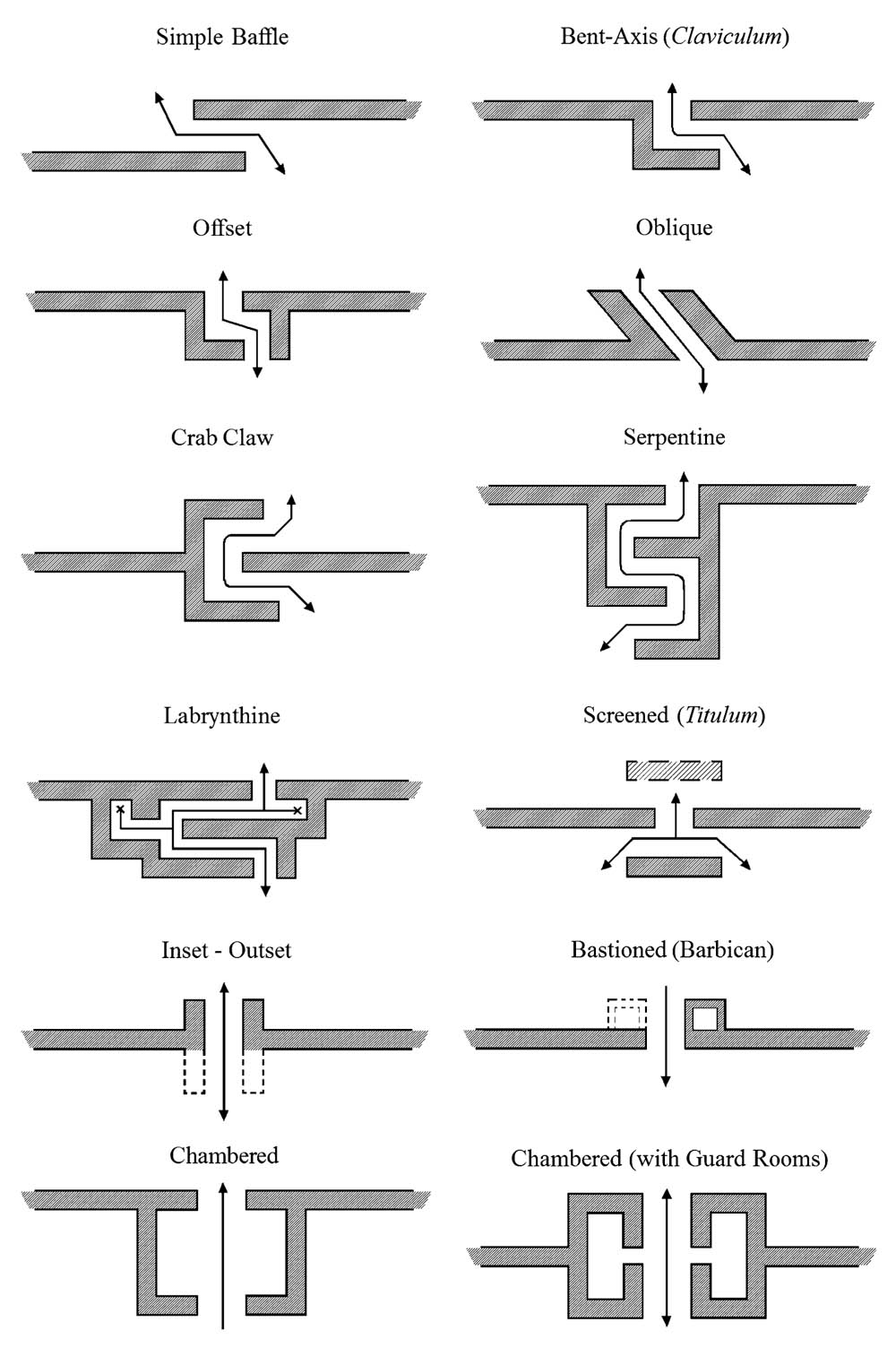 [Image: From “Baffles and Bastions: The Universal Features of Fortifications” by Lawrence H. Keeley, Marisa Fontana, and Russell Quick, courtesy of the Journal of Archaeological Research (5 March 2007)].
[Image: From “Baffles and Bastions: The Universal Features of Fortifications” by Lawrence H. Keeley, Marisa Fontana, and Russell Quick, courtesy of the Journal of Archaeological Research (5 March 2007)].
In a paper called “Baffles and Bastions,” published in the Journal of Archaeological Research, anthropologists Lawrence H. Keeley, Marisa Fontana, and Russell Quick offer a detailed history of militarized building design features such as “V-sectioned ditches, defended gates, and bastions.”
All of the features they subsequently analyze occur at peripheries, borders, and thresholds. In their own words, “the militarily functional ditch and gate features and bastions discussed below, in fact and by definition, are all distinguished by being part of enceintes (that is, surrounding barriers or enclosures). Enceintes are barriers that prevent access to and, almost always, obscure vision of a particular location.”
Their diagrams of “baffled” entryways, seen above, are particularly interesting—a kind of archaeological variation on floor plan porn—revealing the various techniques used to at fortified points of entry to gain an advantage over invaders. Through a navigational encounter with architecture, attackers are forced to show their vulnerabilities. “Baffled gates force attackers who enter them to expose their flanks and rear to defenders’ fire,” the authors write. “Ideally, they require attackers to turn left exposing their unshielded right side. Left-turning baffles also were useful against (typically) right-handed bowmen.”

Amusingly, I see these used in the videogame industry too – not for exposing the flanks of right-handed shield users, but for the purposes of obscuring graphic-heavy areas until they've had time and space to load in.
They're particularly obvious (and odious) in MMOs, but you can find them well hidden in most high-fidelity 3d games too.
And in virtually all spiral staircases in castles and other fortifications, the stairway spins clockwise as you go up… Much tougher to swing a sword when the central pillar is in the way, and much easier for the defenders, ostensibly defending the high ground, to shield and swing!
Very interesting. I was reminded of two military fortification techniques have been incorporated into landscape design.
The 'Ha-Ha Wall' was a development of a specific variety of trench with one steep side and one gently sloping. It has been utilised in European landscape design to create the illusion of a continuous landscape whilst separating the gardens from the surrounding wilderness. Apparently a similar technique had been developed independently in China, long before Europeans applied the ha-ha to landscape design.
Gabions were originally developed by the French military so that walls could be swiftly erected by filling portable cages with
aggregates obtained in situ. Armies across the world still utilise gabions to protect artillery crew, but there used has extended to landscape design and civil engineering, particularly on highways where the use of vernacular stones are usually more pleasing to the eye than concrete.
Or something.
Joey, interesting indeed. It'd be interesting to see Dragon's Teeth pop up in a park someday.
And, Gabriel, thanks, I didn't know that about spiral staircases, actually; fascinating!
Also, you guys might like the next post I just put up here on the blog; it's a kind of digital baffler system, or loop geography.
Geoff, a long while ago I'd proposed dragon's teeth for a park art commission. Sadly, it didn't take.
As usual, a thought-provoking post. The Economist recently had an article on the study of how people in crowds move to avoid bumping into each other and, among other things, various analyses shows how somewhat counterintuitively, placing barriers such as baffles or poles in certtain spots near exits, helps to relieve congestion especially in the panic of fires and other emergencies when crowds swarm to a few exit points.
Another interesting point about the spiral staircases in castles: The height of the individual steps varied. They were called "stumble steps" A defender living in the castle got used to them, while an attacker making his first "visit" to the castle would likely trip going up the stairs.
If you tour a castle today, you would assume they had settled over time or were not built well. Instead, it was good design.
The barrier also disrupts the use of a battering ram to breach a door.